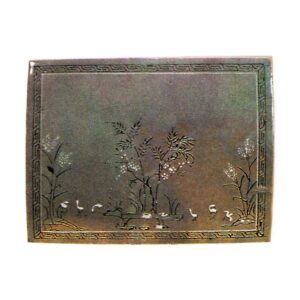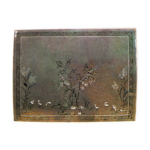
In Korea, ash-glazed porcelain was produced during the Unified Silla Dynasty by applying an ash glaze to the surface of high-fired ash ceramics. This trend of celadon continued almost until the fall of the Goryeo Dynasty and is called Goryeo celadon. The early celadon of the 10th century is not unique, having a blue Yuezhou-style skin with simple engravings. In the eleventh and second centuries, Goryeo celadon porcelain grew into beautiful full-scale celadon porcelain under the influence of imported Song dynasty northern celadon and Longquan ware, as described by Xu Jing, a Song envoy to Goryeo in 1123, in his “Seonhe Bongsa Goryeo Illustrated Sutra. The colorful celadon porcelain is decorated with deep, quiet glaze colors and elaborate seal and painting flower patterns, and is the pinnacle of Goryeo celadon porcelain. In the middle of the 12th century, a completely new and unique Joseon technique was developed. This is known as inlaid celadon, in which the surface of the ware is decorated with engravings, inlaid with black clay, and covered with a celadon glaze. The white and black patterns on the surface of the celadon glaze are submerged under the beautiful celadon glaze, creating a peculiar contrast. It is likely that the technique of mother-of-pearl inlay lacquerware, which was popular at the time, was applied to this piece. In addition to this inlaid celadon, copper oxide is inlaid on rare occasions to produce the red coloring of cinnabar. Iron-painted celadon, in which the surface is painted with iron sand and covered with a celadon glaze, was also widely produced, although probably a little later than inlaid celadon. This is said to be due to the influence of painted Goryeo ware from the Zizhou kilns, but iron-painted celadon from the Guangzhou kilns may have been involved as well. Around the end of the 13th century, when the Song dynasty died out in China and Goryeo came under Yuan rule, the style of celadon began to deteriorate, and the glaze colors of celadon ware declined as both the formations and patterns became more careless. Inlaid celadon eventually disappeared from the Mishima hand. Kilns of Goryeo celadon porcelain are distributed throughout Korea, but those in Sadang-ri, Daeguk-myeon, Jin-gun, Jeollanam-do and Yucheon-ri, Baek-myeon, Buan-gun, Jeollabuk-do are said to have produced the most outstanding pieces.








